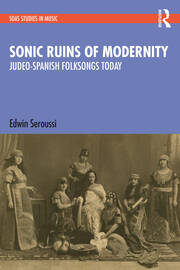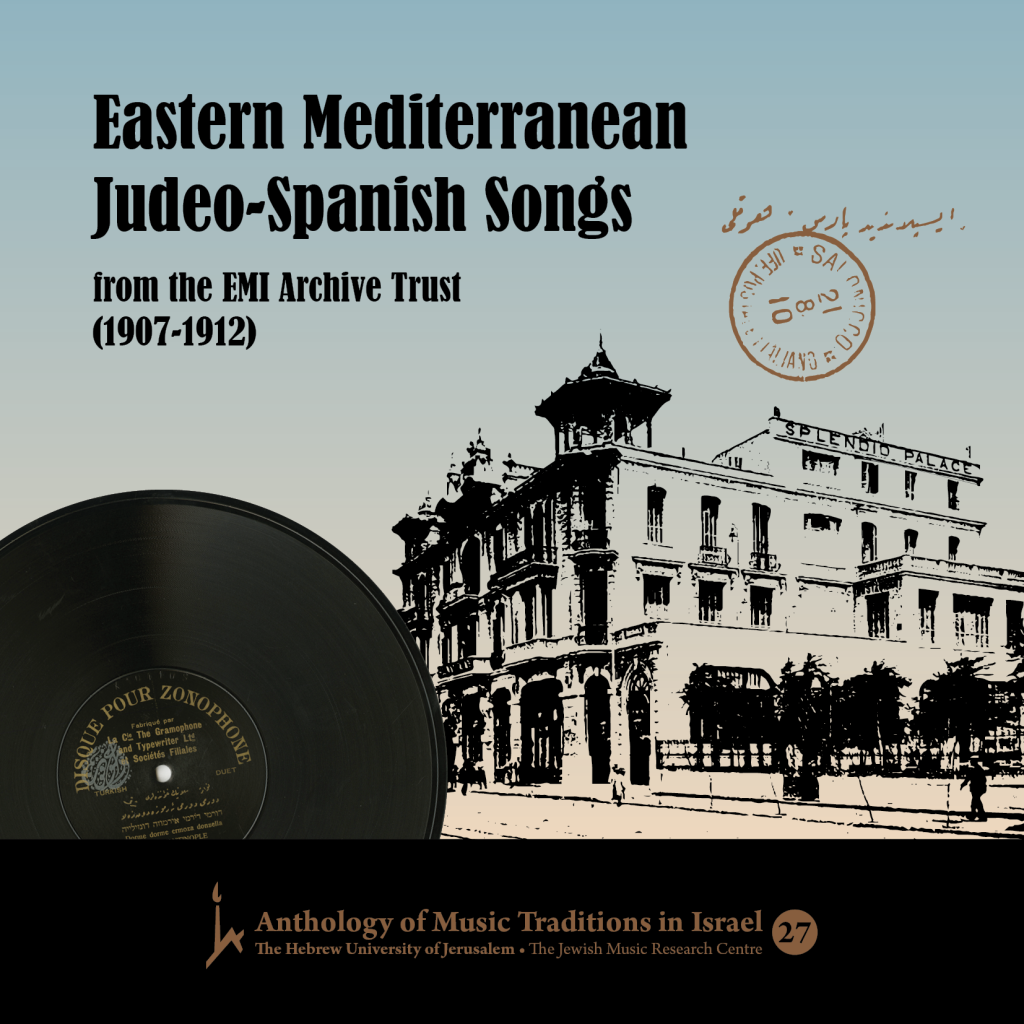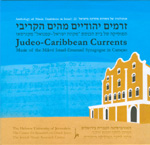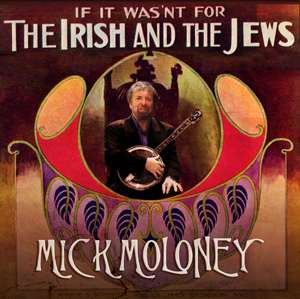You are currently browsing the category archive for the ‘Recording Review’ category.
“Ya Shema Evoynecha,” performed by Carla Berg, original poem in Hebrew by Yehuda Halevi, Ladino lyrics by Rabbi Reuven Eliyahu Yisrael, uploaded September 15, 2022, https://www.youtube.com/watch?v=v2QlJLkgeZw.
Reviewed by Lealiza Lee
The piyyut “Ya Shema Evoyonecha,” by Yehuda Halevi, is most widely known as a component of the Sephardic selichot service. Carla Berg is a vocalist who brings to light a long-forgotten Ladino version of the piyyut in a recording released for Rosh-Hashana.
Read the rest of this entry »Sonic Ruins of Modernity: Judeo-Spanish Folksongs Today. Edwin Seroussi. London: Routledge. 2023.
Reviewed by Lori Sen

A minority within the Jewish people, Sephardim are a triple diasporic population, who carried with them their culture, traditions, language (Judeo-Spanish), and oral literature. Judeo-Spanish folksongs are among the Sephardim’s oral literature and reflect the diverse influences of the many cultures they encountered throughout their five-hundred-year-long journey from medieval Iberia to all over the modern world. With Sonic Ruins of Modernity, musicologist Edwin Seroussi introduces the contemporary concept of folksong (in the post-tradition era) as a sonic ruin, regularly visited by tourists interested in exploring the history of other cultures.
Read the rest of this entry »Eastern Mediterranean Judeo-Spanish Songs from the EMI Archive Trust (1907-1912). Rivka Havassy and Edwin Seroussi. Jerusalem: Jewish Music Research Center, Hebrew University of Jerusalem. 2020.
Reviewed by Vanessa Paloma Elbaz
The EMI Archive Trust houses a collection of Jewish music from the Eastern Sephardim, originally released by Gramophone and Zonophone on 78 RPM between 1907 and 1912. This collection was released by the Jewish Music Research Center as a recording, with a physical CD and an online presence, including liner notes in English and Hebrew, song texts and their translations providing a wealth of material for this review. The collection includes songs in Judeo-Spanish, Hebrew, Turkish and Serbo-Croatian. Ladino selections are numerous, demonstrating the public presence of Ladino in Ottoman urban centers of this area at the time, despite the minority status of its community. The confluence of “the predominantly urban character of the late Ottoman Jewish society and its increasing middle class aspirations and leaning towards Westernization during the last decades of the Empire, coupled with the Jewish ethnicity of some key managerial figures of the European record companies, contributed to the presence of the song in Ladino in the early Eastern Mediterranean discography” (11-12). As was also the case with early Judeo-Arabic recordings, Jewish producers almost monopolized positions of local representation for international recording companies. This may have been partially due to the legacy of the Alliance Israelite Universelle’s training in French for Mediterranean Jews since the nineteenth century, which facilitated exchange and collaboration with European companies by the early twentieth century. Such collaboration allowed local musicians to create a dynamic market for the recording of Jewish artists and repertoires throughout the Ottoman empire and North Africa as recording technologies were developed and monetized. Another release (from 2008) from the JMRC in this broad category is focuses on Odeon’s recordings of Haim Effendi from 1907 in Turkey.
Read the rest of this entry »Klezmer Shpil. with Arkady Goldenshtein, clarinet. Emil Kroiter, accordion, composer-arranger. Israel: OR-TAV Music Publications/Klezmerhouse, 2007. compact disc.
Reviewed by Jardena Gertler-Jaffe
 Klezmer Shpil is a collaboration between clarinetist Arkady Goldenshtein and accordionist Emil Kroitor. Its sixteen tracks were composed and arranged by Kroitor and performed by an ensemble brought together specifically for this album, which was released by OR-TAV Music Publications in 2007. Every track prominently features Kroitor and Goldenshtein, as well as violinist Isaac Kurtz, together playing impressive contrapuntal and ornamented lines. As an ethnomusicologist and klezmer enthusiast, I am intrigued by new klezmer music and the debates that surround it. With regard to this recording, my challenge is to appreciate its musical accomplishments while remaining critical of its presentation of an uncomplicated view of the lineage and heritage of klezmer. Read the rest of this entry »
Klezmer Shpil is a collaboration between clarinetist Arkady Goldenshtein and accordionist Emil Kroitor. Its sixteen tracks were composed and arranged by Kroitor and performed by an ensemble brought together specifically for this album, which was released by OR-TAV Music Publications in 2007. Every track prominently features Kroitor and Goldenshtein, as well as violinist Isaac Kurtz, together playing impressive contrapuntal and ornamented lines. As an ethnomusicologist and klezmer enthusiast, I am intrigued by new klezmer music and the debates that surround it. With regard to this recording, my challenge is to appreciate its musical accomplishments while remaining critical of its presentation of an uncomplicated view of the lineage and heritage of klezmer. Read the rest of this entry »
Judeo-Caribbean Currents: Music of the Mikvé Israel-Emanuel Synagogue in Curaçao. Gideon Zelermyer, hazzan; Raymond Goldstein, piano. Liner notes by Edwin Seroussi. Anthology of Music Traditions in Israel 22. Jerusalem: Jewish Music Research Centre, 2009.
The United Netherlands-Portuguese Congregation Mikvé Israel-Emanuel in Curaçao is the oldest Jewish congregation in the Western hemisphere. Formally established in 1654 in the walled city of Willemstad, the synagogue served as a place of worship for the first Portuguese Jewish immigrants who arrived in Curaçao from Amsterdam. This population—likely descendants of the original Sephardic Jewish population that left the Iberian peninsula during the Inquisition—was later joined by Jews emigrating from Brazil and elsewhere; by 1800, there were nearly 2000 Jews in Curaçao, comprising fully half the white population of this southern Caribbean island. In 1864, a schism resulted in the establishment of a second congregation—Temple Emanuel—that has the distinction of being what Edwin Seroussi describes as “the first overtly Reform Sephardic congregation ever” (12). A century later, this ideological split was resolved and, in 1964, the two were reunited; today, the United Netherlands Portuguese Congregation Mikvé Israel-Emanuel is affiliated with the American Jewish Reconstructionist movement. Read the rest of this entry »
The Naming. Galeet Dardashti. Galeet Dardashti, 2010.
In the Genesis creation account God speaks and the world springs into existence, light and dark, water and sky, earth and seas. The voice is coextensive with creation. Galeet Dardashti’s new recording The Naming can claim no such miraculous speech acts, but her music recalls both the creative power of the voice and a near-divine ability to bring women to life.
Dardashti’s Persian-Jewish heritage and academic training come together in a beautiful and yet theologically provocative recording. The music is at once traditional and radical: the first song begins with the prayer for laying tefillin but in a woman’s voice, while “Dinah” incorporates a traditional Moroccan piyyut, and “Sarah/Hagar” includes recent Hebrew and Arabic headlines about political violence. At times Dardashti employs a Mizrahi cantorial style, to which her rich voice brings depth and emotion. Even her own personal lineage leaves an imprint on the sound: her father, cantor Farid Dardashti, sings in “Endora.” Perhaps the most striking moments in the recording, however, are in the songs composed of biblical verses. Their radical character lies not simply in the verses themselves, but rather in Dardashti’s midrashic construction of the songs: the presence, absence, order, and juxtaposition of verses can ultimately be read as bold reinterpretations of the power, the agency, and the simple humanity of the biblical women. Read the rest of this entry »
If It Wasn’t for the Irish and the Jews. Mick Moloney. Compass Records, 2009.
I first enjoyed Mick Moloney and The Green Fields of America some twenty years ago at a national meeting of the American Conference for Irish Studies. Moloney, a talented musician-singer and folklorist who is also a Professor of Music and Irish Studies at New York University, formed the group in the later 1970s and, at least in my memory of the evening, offered a program in which traditional reels, jigs, and step dancing predominated. In the past few years, however, Moloney’s considerable energies have been directed more specifically at America’s Tin Pan Alley era, a time in which Irish and Jewish songwriters—separately and collaboratively—created a popular music expressive of some of the moment’s most pervasive social issues: the struggles of newly arrived immigrants, their often tense internal negotiations between assimilation and nostalgia, and the specter of World War I. Moloney’s earlier album McNally’s Row of Flats (Compass, 2006) treats the highly successful collaboration of Edward Harrigan and David Braham; thus, If It Wasn’t for the Irish and the Jews might be regarded as a further iteration of Moloney’s fascination with American popular music between 1880 and 1920. Read the rest of this entry »
Herencia Judía. Benjamin Lapidus. Tresero Productions, 2008.
Timba Talmud. Roberto Rodriguez/Sexteto Rodriguez. Tzadik, 2009.
Herencia Judía and Timba Talmud are recordings that fuse Afro-Caribbean (mainly Cuban) and Jewish (Ashkenazic and Sephardic) traditions. While Roberto Rodriguez/Sexteto Rodriguez’s compilation is largely dance music derived from popular Cuban and klezmer repertoire to be enjoyed in the home or in secular engagements, Lapidus’s album takes on the difficult task of arranging piyyutim (paraliturgical hymns) and texts from Jewish holidays with secular and religious musics of the Spanish Caribbean. Lapidus and Rodriguez’s impressions of musical encounter are presented as audiotopias—ideological spaces that offer the listener and/or the musician new maps for re-imagining the present social world.[1] They are spaces with no real place where ideological contradictions and conflicts may coexist.[2] Yet, the proliferation of a variety of Cuban musical idioms such as rumba, son, cha-cha-chá, mambo, and comparsa assure a focus on Cuban sound on both albums. Ultimately, by playing with musical materials from Afro-Caribbean, Cuban, and Jewish traditions, both Lapidus and Rodriguez must contend with the difficulties of finding a coherent musical point of view. In this respect, Rodriguez more successfully streamlines his vision, maintaining a focus on (predominantly) popular styles and images in comparison to Lapidus, whose strategy can feel almost overwhelmingly eclectic at times. Read the rest of this entry »
Songs of Peace. Rabbi Shlomo Carlebach. Sojourn Records, 2010.
Higher & Higher. Neshama Carlebach and The Green Pastures Baptist Choir. Sojourn Records, 2010.
Jewish ethnomusicology in its current form is a relatively new field. In the past few decades there has been a flurry of studies and reviews that have dealt with the origins of Jewish music and various ethnic musical traditions, including American Jewish music. It therefore seems somewhat surprising that (as far as I know) there has been little work published on the prolific and influential musical career of Rabbi Shlomo Carlebach, arguably the most well-known composer and performer of traditional Jewish music in the post-war period.
Below I review two very different Carlebach compilations. The first, Songs of Peace, includes selections from two previously unreleased live performances in 1973. The second, Higher & Higher, represents another branch of the Carlebach industry: the work of his interpreters, in this case his eldest daughter Neshama Carlebach. Read the rest of this entry »
‘Empezar Quiero Contar’: Canciones de Sefarad. 2000. Pneuma PN-370. CD & booklet, 31 pages. Liner notes by Judith R. Cohen.
Sefarad en Diáspora. 2006. Pneuma PN-780. CD & booklet, 23 pages. Liner notes by Judith R. Cohen.
From the perspective of someone who derives little aesthetic pleasure from folksongs, but recognizes that bringing Jewish history to life in the classroom sometimes entails glancing up from conventional, printed texts, these recent CDs by ethnomusicologist and performer Judith R. Cohen are worthy of serious consideration. The use of traditional music in the classroom can help maintain attention spans. But music can also be a learning tool, and, as Cohen often demonstrates, some essential aspects of Jewish civilization can only be adequately contemplated by using our aural faculty.








